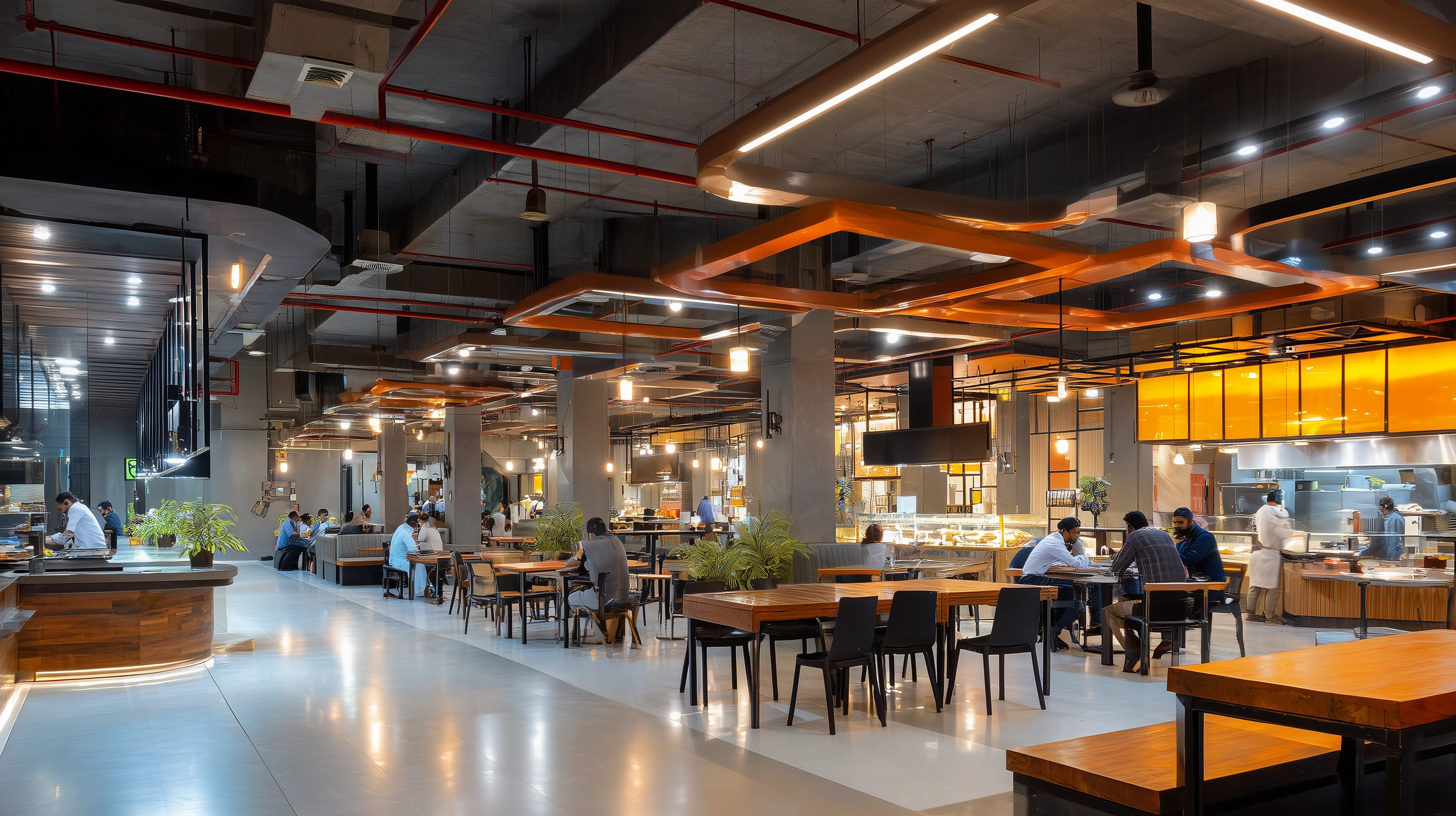Corporate Catering Industry Analysis 2025: Market Trends, Growth Drivers & Future Outlook

The corporate catering industry stands at an inflection point in 2025, driven by evolving workplace dynamics, technological innovation, and changing employee expectations. As businesses recognize food services as strategic investments rather than operational expenses, the industry is experiencing unprecedented transformation and growth.
Executive Summary: A Market in Rapid Expansion
The global catering services market has demonstrated remarkable resilience and growth, reaching $154.71 billion in 2024 and projected to expand to $229.92 billion by 2033, representing a compound annual growth rate (CAGR) of 4.28% according to IMARC Group research¹. In the United States alone, the catering industry generated $72 billion in revenue in 2023 and is expected to climb to $124 billion by 2032, with a robust 6.2% annual growth rate².
India's Emerging Market Dynamics
India's catering services market presents particularly compelling opportunities, valued at $5.10 billion in 2024 and projected to reach $7.39 billion by 2033 with a 4.30% CAGR³. The broader Indian food service market shows even stronger growth potential, estimated at $85.19 billion in 2025 and expected to reach $139.8 billion by 2030, growing at an impressive 10.41% CAGR⁴.
This growth trajectory positions India as one of the most dynamic markets for corporate catering services globally, driven by rapid urbanization, an expanding corporate sector, and increasing awareness of workplace nutrition benefits.
Key Market Drivers Reshaping the Industry
1. Post-Pandemic Workplace Evolution
The COVID-19 pandemic fundamentally altered workplace expectations around food services. Companies are now investing in comprehensive meal programs to:
- Attract talent back to offices through enhanced workplace amenities.
- Support hybrid work models with flexible catering solutions.
- Demonstrate employee care through quality nutrition programs.
- Foster team collaboration through shared dining experiences.
2. Technology Integration and Digital Transformation
The industry is experiencing rapid digitalization, with key technological adoptions including:
- AI-Powered Menu Optimization: Machine learning algorithms analyze employee preferences, dietary restrictions, and consumption patterns to optimize menu planning and reduce food waste.
- IoT-Enabled Supply Chain Management: Smart sensors and tracking systems ensure food safety compliance, temperature monitoring, and real-time inventory management.
- Mobile-First Ordering Platforms: Seamless app-based ordering systems with personalization features, nutritional tracking, and payment integration.
- Data Analytics and Reporting: Comprehensive dashboards providing insights into consumption patterns, cost optimization, and employee satisfaction metrics.
3. Sustainability and Environmental Consciousness
Corporate clients increasingly prioritize sustainability in vendor selection, driving industry adoption of:
- Local sourcing initiatives reducing carbon footprint and supporting regional economies.
- Waste reduction programs including composting, packaging optimization, and portion control.
- Plant-based menu expansion responding to environmental and health consciousness.
- Sustainable packaging solutions eliminating single-use plastics and implementing biodegradable alternatives.
Regulatory Landscape and Compliance Requirements
FSSAI Compliance in India's Corporate Catering Sector
India's Food Safety and Standards Authority (FSSAI) has implemented comprehensive regulations affecting corporate catering operations. Key compliance requirements include:
- Licensing and Registration: All catering operations must obtain appropriate FSSAI licenses based on scale and scope of operations⁵.
- Food Safety Management Systems: Implementation of Hazard Analysis and Critical Control Points (HACCP) principles for systematic food safety management.
- Nutritional Labeling Requirements: New FSSAI mandates effective July 2024 require display of nutritional information including total sugar, salt, and saturated fat content⁶.
- Hygiene and Sanitation Standards: Strict protocols for food handling, preparation, storage, and transportation to ensure consumer safety.
International Standards and Best Practices
Global corporate catering operations increasingly adopt international standards including:
- ISO 22000 for food safety management systems
- BRC Global Standards for food safety and quality
- SQF (Safe Quality Food) certification programs
- HACCP implementation across all operational levels
Emerging Trends Defining the Future
1. Personalized Nutrition and Health-Focused Menus
The industry is shifting toward individualized nutrition programs, incorporating:
- Dietary Accommodation: Comprehensive support for medical dietary requirements, religious preferences, and lifestyle choices including vegan, keto, and gluten-free options.
- Nutritional Transparency: Detailed caloric and nutritional information for all menu items, enabling informed food choices.
- Wellness Integration: Coordination with corporate wellness programs, health insurance benefits, and occupational health initiatives.
- Functional Foods: Integration of superfoods, probiotics, and nutrient-dense ingredients supporting cognitive function and energy levels.
2. Flexible Service Models
Modern corporate catering embraces flexibility through:
- Hybrid Work Support: Adaptable programs serving both in-office and remote employees through meal kits, voucher systems, and satellite locations.
- Scalable Solutions: Dynamic capacity management accommodating fluctuating headcounts and seasonal variations.
- Multi-Location Coordination: Standardized service delivery across multiple office locations with local customization capabilities.
- Event Integration: Seamless coordination between daily meal services and special event catering requirements.
3. Premium Experience Focus
Corporate clients increasingly expect restaurant-quality experiences including:
- Culinary Innovation: Chef-driven menus featuring global cuisines, seasonal specialties, and artisanal preparations.
- Presentation Excellence: Instagram-worthy food presentation supporting social media engagement and employee satisfaction.
- Interactive Dining: Live cooking stations, customization bars, and chef demonstrations enhancing the dining experience.
- Ambient Design: Thoughtfully designed dining spaces supporting collaboration, relaxation, and productivity.
Competitive Landscape Analysis
Market Consolidation Trends
The corporate catering industry is experiencing consolidation as larger players acquire specialized service providers to expand capabilities and geographic reach. Key consolidation drivers include:
- Technology investment requirements favoring larger operators with development resources.
- Compliance complexity requiring specialized expertise and systems.
- Client preference for single-vendor solutions across multiple locations and service types.
- Economies of scale in procurement, logistics, and operational efficiency.
Differentiation Strategies
Successful corporate catering companies differentiate through:
- Specialized Expertise: Deep industry knowledge in specific sectors (technology, healthcare, manufacturing) enabling tailored solutions.
- Technology Leadership: Proprietary platforms providing superior user experiences and operational efficiency.
- Sustainability Credentials: Verified environmental programs and certifications appealing to ESG-conscious corporate clients.
- Cultural Competency: Understanding of local food preferences, dietary customs, and cultural sensitivities.
Financial Performance and Investment Outlook
Revenue Growth Patterns
Industry financial performance demonstrates strong fundamentals:
- Recurring Revenue Models: Corporate contracts typically span 1-3 years, providing predictable revenue streams and enabling long-term planning.
- Premium Pricing Power: Quality-focused operators command 15-25% premium pricing compared to basic service providers.
- Operational Leverage: Established operations demonstrate strong scalability with incremental margin improvement as volume increases.
- Technology ROI: Digital transformation investments show 18-24 month payback periods through operational efficiency gains.
Investment and Funding Trends
The corporate catering sector attracts significant investment interest:
- Private Equity Focus: Growth capital investments targeting technology-enabled operators with strong market positions.
- Strategic Acquisitions: Food service giants acquiring specialized corporate catering companies to expand service portfolios.
- Technology Partnerships: Collaborations between catering companies and technology providers developing industry-specific solutions.
- Sustainability Investments: Capital allocation toward environmental programs, sustainable sourcing, and waste reduction initiatives.
Strategic Recommendations for Industry Participants
For Established Operators
- Technology Integration: Prioritize investment in digital platforms, data analytics, and automation technologies to maintain competitive advantages.
- Service Portfolio Expansion: Develop comprehensive offerings including event catering, retail partnerships, and employee benefit programs.
- Geographic Expansion: Target high-growth markets with strong corporate presence and favorable regulatory environments.
- Sustainability Leadership: Implement measurable environmental programs differentiating from competitors and appealing to ESG-focused clients.
For New Market Entrants
- Niche Specialization: Focus on specific industry verticals, dietary requirements, or service models to establish market position.
- Technology-First Approach: Build operations around digital platforms and data-driven decision making from inception.
- Partnership Strategies: Collaborate with established players, technology providers, and local suppliers to accelerate market entry.
- Regulatory Compliance: Invest in comprehensive compliance systems and expertise to ensure sustainable operations.
Future Outlook: Industry Projections for 2025-2030
Market Growth Expectations
Industry analysts project continued strong growth driven by:
- Corporate Expansion: Increasing number of companies implementing formal meal benefit programs as talent retention strategies.
- Service Premiumization: Growing demand for high-quality, restaurant-style corporate dining experiences.
- Technology Adoption: Continued investment in digital solutions improving operational efficiency and customer experience.
- Health Consciousness: Rising awareness of workplace nutrition's impact on productivity and employee wellbeing.
Emerging Opportunities
- Micro-Market Solutions: Automated food service solutions for smaller office environments and satellite locations.
- Nutrition-as-a-Service: Comprehensive wellness programs integrating meal services with health monitoring and coaching.
- Sustainable Sourcing Networks: Development of local supplier ecosystems supporting environmental and community objectives.
- International Expansion: Cross-border service delivery supporting multinational corporate clients.
Conclusion: Positioning for Success in a Dynamic Market
The corporate catering industry in 2025 presents exceptional opportunities for companies that understand evolving client needs, embrace technological innovation, and prioritize operational excellence. Success requires strategic focus on:
- Client-centric service design addressing specific workplace nutrition challenges.
- Technology integration enabling scalable, efficient operations.
- Sustainability leadership meeting corporate environmental objectives.
- Regulatory compliance ensuring long-term operational viability.
- Financial discipline maintaining profitable growth while investing in capabilities.
Organizations that master these elements will capture disproportionate value in this expanding market, establishing sustainable competitive advantages and driving long-term growth. The industry's trajectory toward $229.92 billion globally by 2033 represents not just market expansion, but a fundamental transformation in how businesses approach workplace nutrition as a strategic investment in human capital.
Sources:
- IMARC Group - Global Catering Services Market Report 2024
- Curate.co - 2025 Catering Industry Trends Report
- IMARC Group - India Catering Services Market Analysis 2024
- Mordor Intelligence - India Foodservice Market Report 2025
- FSSAI - Food Safety and Standards Regulations 2024
- India Briefing - FSSAI Food Labeling Regulations Update 2024
